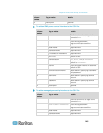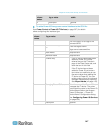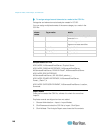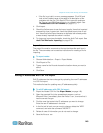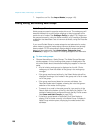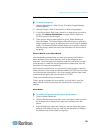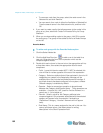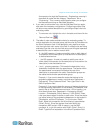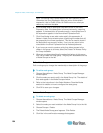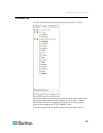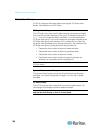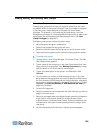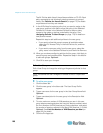
Chapter 8: Nodes, Node Groups, and Interfaces
153
An example rule might be Department = Engineering, meaning it
describes all nodes that the category “Department” set to
“Engineering.” This is exactly what happens when you configure
the associations during an Add Node operation.
4. If you want to add another rule, click the Add New Row icon again,
and make the necessary configurations. Configuring multiple rules
will allow more precise descriptions by providing multiple criteria for
evaluating nodes.
To remove a rule, highlight the rule in the table, and then click the
Remove Row icon .
5. The table of rules makes available criteria for evaluating nodes. To
write a description for the node group, add the rules by Rule Name to
the Short Expression field. If the description only requires a single
rule, then type that rule's name in the field. If multiple rules are being
evaluated, type the rules into the field using a set of logical operators
to describe the rules in relation to each other:
& - the AND operator. A node must satisfy rules on both sides of
this operator for the description (or that section of a description)
to be evaluated as true.
| - the OR operator. A node only needs to satisfy one rule on
either side of this operator for the description (or that section of a
description) to be evaluated as true.
( and ) - grouping operators. This breaks the description into a
subsection contained within the parentheses. The section within
the parentheses is evaluated first before the rest of the
description is compared to the node. Parenthetical groups can
be nested inside another parenthetical group.
Example 1: If you want to describe nodes that belong to the
engineering department, create a rule that says Department =
Engineering. This will become Rule0. Then, type Rule0 in the
Short Expression field.
Example 2: If you want to describe a group of devices that belong
to the engineering department or are located in Philadelphia, and
specify that all of the machines must have 1 GB of memory, you
must create three rules. Department = Engineering (Rule0)
Location = Philadelphia (Rule1) Memory = 1GB (Rule2).These
rules must be arranged in relation to each other. Since the device
can either belong to the engineering department or be located in
Philadelphia, use the OR operator, |, to join the two: Rule0 |
Rule1. Make this comparison first by enclosing it parentheses:
(Rule0 | Rule1). Since the devices must both satisfy this
comparison AND contain 1GB of memory, use the AND
connector, &, to join this section with Rule2: (Rule0 | Rule1) &
Rule2. Type this final expression in the Short Expression field.



